Online education enrollment increased by 73% between 2019 and 2023. This created unprecedented challenges for employers verifying digital credentials through background check processes. This comprehensive guide explains how modern verification systems authenticate online degrees. It covers the technologies used to detect diploma fraud and best practices for ensuring accredited online university verification across hiring workflows in 2025.
Key Takeaways
- Online degree verification background check processes use National Student Clearinghouse databases, direct university registrar contact, and blockchain technology. These methods authenticate digital credentials with 95% accuracy rates.
- Accredited online universities are verified through the same rigorous background check protocols as traditional institutions. This utilizes Department of Education databases and regional accreditation body confirmations.
- Digital diploma verification processes typically require 3-7 business days for completion. However, instant verification services now authenticate 68% of credentials within 24 hours through automated clearinghouse systems.
- Diploma mills account for approximately $200 million in fraudulent degree sales annually. This makes thorough verification essential for maintaining workplace integrity and FCRA compliance.
- Third-party verification services charge between $15-$75 per credential check. Comprehensive background screening packages offer better value for organizations conducting multiple verifications.
- FCRA regulations require employers to obtain written consent before conducting education verification. They must also provide adverse action notices if credentials cannot be confirmed or are fraudulent.
- International online degree verification adds 5-10 additional business days. This is due to time zone differences, language barriers, and varying educational system structures across 195 countries.
- Incomplete or unverifiable education records appear in approximately 15-20% of background checks. This requires HR professionals to establish clear policies for handling discrepancies and candidate communication protocols.
Understanding the Digital Diploma Verification Process
The shift from traditional to online education has fundamentally transformed credential verification. Employers now verify academic credentials during pre-employment screening using new methods. Digital diploma verification processes incorporate sophisticated technology platforms. These include database cross-referencing and multi-step authentication protocols to confirm online degree legitimacy. As of 2025, approximately 42% of all college students are enrolled in at least one online course. Meanwhile, 19% pursue their degrees entirely through distance learning programs.
Traditional degree verification relied heavily on phone calls to registrar offices. It also used mailed transcripts with raised seals. Today's digital verification ecosystem uses electronic databases, API integrations, and blockchain technology. These tools authenticate credentials faster and more accurately. The National Student Clearinghouse serves as the primary verification hub. It maintains enrollment and degree records for over 3,600 institutions. This represents 98% of students in public and private U.S. schools.
Background check companies now employ three primary verification methods. These provide different turnaround times, accuracy levels, and cost structures:
- Automated database searches: Clearinghouse systems provide instant or 24-hour results for participating institutions
- Direct electronic verification portals: Universities establish secure online systems for credential authentication
- Traditional registrar contact: Phone and email verification for institutions without digital infrastructure
Each method offers distinct advantages. These depend on institutional participation, verification urgency, and budget constraints. Employers must consider these factors when designing their screening protocols.
Primary Verification Methods for Online Credentials
Modern background screening services utilize multiple verification pathways. These authenticate online degree credentials efficiently. The National Student Clearinghouse DegreeVerify service provides instant or 24-hour verification for most accredited institutions. It returns degree type, major, conferral date, and attendance dates. When clearinghouse data is unavailable, verification specialists contact university registrar offices directly. They use secure electronic portals or traditional phone verification protocols.
| Verification Method | Turnaround Time | Coverage Rate | Cost Range |
| National Student Clearinghouse | 24-48 hours | 98% of U.S. institutions | $15-$25 |
| Direct Registrar Contact | 5-7 business days | Non-participating schools | $30-$50 |
| Blockchain Verification | Instant | Less than 5% of institutions | $10-$20 |
| International Verification | 7-14 business days | Global institutions | $40-$75 |
Third-party credential verification services like NACES member organizations specialize in authenticating international online degrees. They also convert foreign credentials to U.S. equivalents. These services become essential when candidates have completed online programs through non-U.S. institutions. They're also needed for hybrid international programs.
EXPERT INSIGHT: As an HR professional, I came to understand that online verification of degrees has nothing to do with skepticism, but it's all about fairness. With the increasing number of people taking online courses, it’s about time we did what’s best for these candidates, as well as what’s best for us, by ensuring they have indeed attained those degrees. It’s not just about protecting ourselves from those who would like to defraud us, but about protecting those many good candidates too. - Charm Paz, CHRP
Technology Infrastructure Behind Digital Verification
The technology supporting online degree verification background check systems has evolved dramatically since 2020. Blockchain-based credentialing platforms now allow universities to issue tamper-proof digital diplomas. Employers can verify these credentials instantly through QR codes or cryptographic validation. MIT's Digital Credentials Consortium, launched in 2021, exemplifies this approach. It uses verifiable digital diplomas that candidates control and share through secure digital wallets.
Artificial intelligence and machine learning algorithms now detect fraudulent credentials. They analyze document authenticity markers and cross-reference enrollment databases. They also identify suspicious patterns across multiple verification requests. These systems flag potential diploma mills, forged transcripts, and credential discrepancies with 92% accuracy. This happens before human verification specialists complete manual reviews. Natural language processing algorithms also analyze credential language patterns. They identify diploma mills through suspicious phrasing, formatting inconsistencies, and grammar errors.
Verification Timelines and Processing Standards
Standard education verification timelines vary based on several factors. These include institutional cooperation, database availability, and verification complexity. Automated clearinghouse verifications through the National Student Clearinghouse typically complete within 24-48 hours. This applies to participating institutions. Direct registrar contact for non-participating schools requires 5-7 business days on average. Some institutions take 10-15 days during peak periods like graduation seasons.
International online degree verification extends these timelines considerably. Credentials from European, Asian, or Latin American online universities typically require 7-14 business days. This accounts for time zone coordination and language translation requirements. It also includes varying privacy regulations that govern educational record disclosure across different countries.
How to Verify Online College Degrees: Step-by-Step Protocol
Implementing a systematic approach to online degree verification ensures compliance, consistency, and accuracy. HR professionals should establish documented procedures. These should outline verification steps, responsibility assignments, and escalation protocols for handling discrepancies. A comprehensive verification protocol protects organizations from negligent hiring claims. It also respects candidate privacy rights under FCRA regulations.
The verification process begins before background checks commence. It starts with candidate consent and accurate information collection. FCRA compliance requires employers to obtain written authorization before conducting any background investigation. This includes education verification. Candidates must provide complete details. These include institution name, degree type, major, graduation date, and specific campus location. This is especially important for online programs operating multiple sites.
Once authorization is secured, verification specialists initiate database searches. They conduct registrar contacts and document authentication reviews. Quality background screening providers maintain detailed audit trails. These document each verification attempt and communication with educational institutions. They also track final determination rationale.
Pre-Verification Preparation and Information Gathering
Effective verification starts with collecting comprehensive candidate information during the application phase. Request candidates provide institution names exactly as they appear on official transcripts. This includes any "online" or "distance learning" designations. These distinguish virtual programs from campus-based offerings. Many universities operate both traditional and online programs under different accreditation or naming structures. This makes precise identification critical.
Quality background screening providers maintain detailed audit trails. These document each verification attempt and communication with educational institutions. They also track final determination rationale.
These essential data points must be collected before initiating verification:
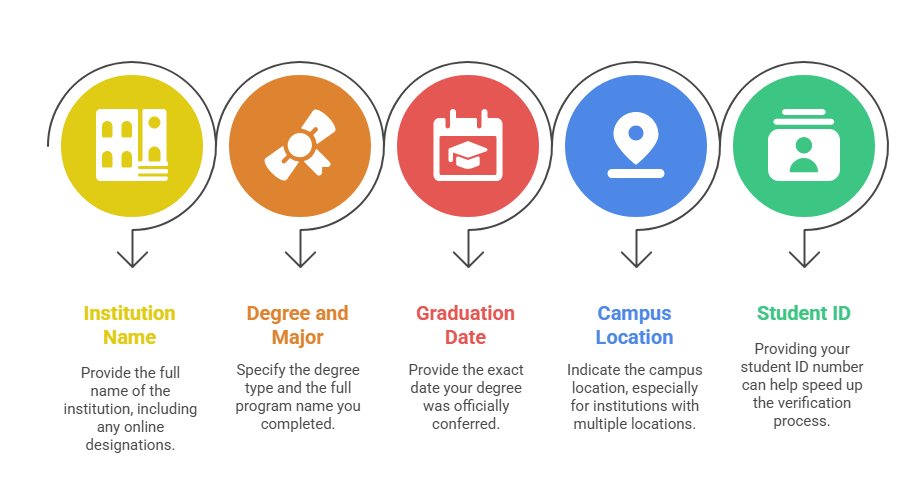
- Complete institution name: Including any online designation or branch campus identification
- Degree type and major: Specific credential earned with full program name
- Graduation date: Actual conferral date rather than last attendance date
- Campus location: Physical or online program distinction for multi-location schools
- Student ID number: Optional but expedites registrar searches when provided
Candidates should also disclose any institutional name changes, mergers, or acquisitions. These may have occurred during their enrollment period. Approximately 8% of online degree verifications encounter complications. This happens because institutions rebranded, merged with other schools, or closed operations after credential conferral.
Database and Clearinghouse Verification Procedures
The first verification step involves searching the National Student Clearinghouse database. This provides the fastest and most cost-effective authentication method for participating institutions. Background screening companies with clearinghouse agreements submit electronic verification requests. These contain candidate information. They receive automated responses within minutes for 68% of queries.
Successful verifications return several key pieces of information. These include degree type, major, conferral date, honors distinctions, and enrollment periods. When clearinghouse searches return "no record found" results, verification specialists escalate to direct registrar contact. They use institutional verification portals or phone communication. Many accredited online university verification systems now operate dedicated employer verification webpages. These include submission forms, fee schedules, and estimated turnaround times.
Universities typically charge $5-$25 per verification request. Expedited processing is available for additional fees.
Handling Unverifiable or Discrepant Results
Approximately 15-20% of education verification attempts result in unverifiable credentials. They may also show discrepancies between candidate-provided information and institutional records. Establishing clear policies for these situations protects organizational integrity. It also gives candidates appropriate opportunities to address issues. FCRA's adverse action requirements mandate that employers provide candidates with pre-adverse action notices. This applies when verification discrepancies might influence hiring decisions.
Common verification discrepancies include:
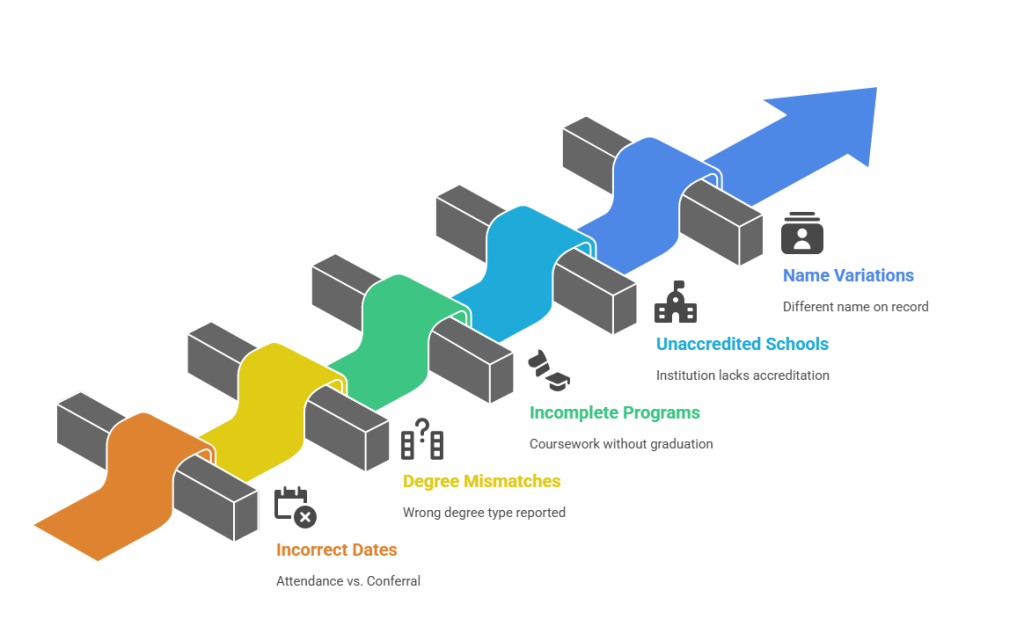
- Incorrect graduation dates: Confusion between final attendance and official degree conferral
- Degree type mismatches: Associate's degree reported as Bachelor's or vice versa
- Incomplete programs: Candidate claimed degree but only completed coursework without graduation
- Unaccredited institutions: School lacks recognized accreditation status
- Name variations: Records under different name than candidate currently uses
Candidates receive copies of background check reports and summaries of their rights. They also get reasonable time periods (typically 5-7 business days) to dispute findings. They can provide clarifying documentation during this period. This process protects candidates from errors. It also allows employers to make informed hiring decisions based on accurate credential verification.
Accredited Online University Verification Standards
Understanding accreditation status forms the foundation of legitimate online degree verification background check processes. Accredited institutions meet rigorous quality standards. These are established by regional or national accrediting agencies. The U.S. Department of Education and the Council for Higher Education Accreditation (CHEA) recognize these agencies. As of 2025, approximately 89% of legitimate online degree programs operate under regionally accredited universities. Meanwhile, 11% hold specialized or national accreditation appropriate to their educational focus.
The Department of Education maintains the Database of Accredited Postsecondary Institutions and Programs (DAPIP). This provides free public access to verify institutional accreditation status. Employers should cross-reference candidate institutions against this database. This should happen before accepting credentials as legitimate qualifications. Regional accrediting bodies provide additional verification resources through their public directories. These include the Higher Learning Commission, Middle States Commission, and WASC Senior College and University Commission.
Distinguishing between legitimate online universities and diploma mills requires understanding accreditation legitimacy markers. Diploma mills often claim accreditation from unrecognized agencies. These have official-sounding names designed to deceive employers. The Department of Education's list of recognized accrediting agencies contains only 70-75 legitimate organizations. This makes verification straightforward for trained HR professionals.
Regional vs. National Accreditation for Online Programs
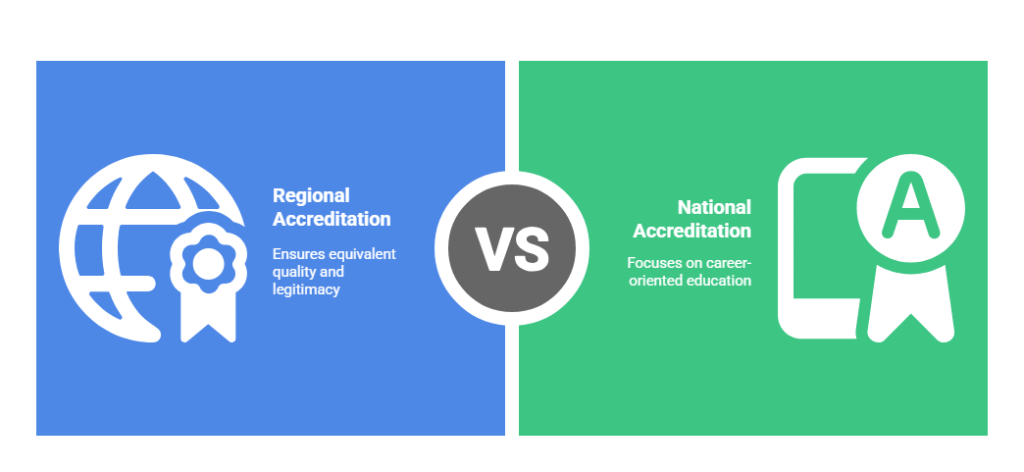
Regional accreditation represents the gold standard for online degree programs. Six regional agencies oversee traditional universities that expanded into distance education. Schools like Arizona State University Online, Penn State World Campus, and University of Florida Online operate under the same regional accreditation. This is the same as their campus-based programs, ensuring equivalent quality standards. Degrees from regionally accredited online programs carry identical weight and legitimacy. This applies during verification processes just as it does for traditional degrees.
National accreditation typically applies to career-focused, vocational, or specialized institutions. This includes many for-profit online universities. While legitimate, nationally accredited schools may face greater scrutiny during verification. Some employers perceive them as less rigorous than regionally accredited alternatives. Examples include DEAC-accredited institutions like Columbia Southern University and Penn Foster College. These provide career-oriented online education meeting national quality standards.
Identifying and Flagging Diploma Mills
Diploma mills generate approximately $200 million annually. They sell fraudulent degrees to candidates seeking credential shortcuts. These operations exhibit several warning signs. Verification specialists use these to identify fraudulent credentials:
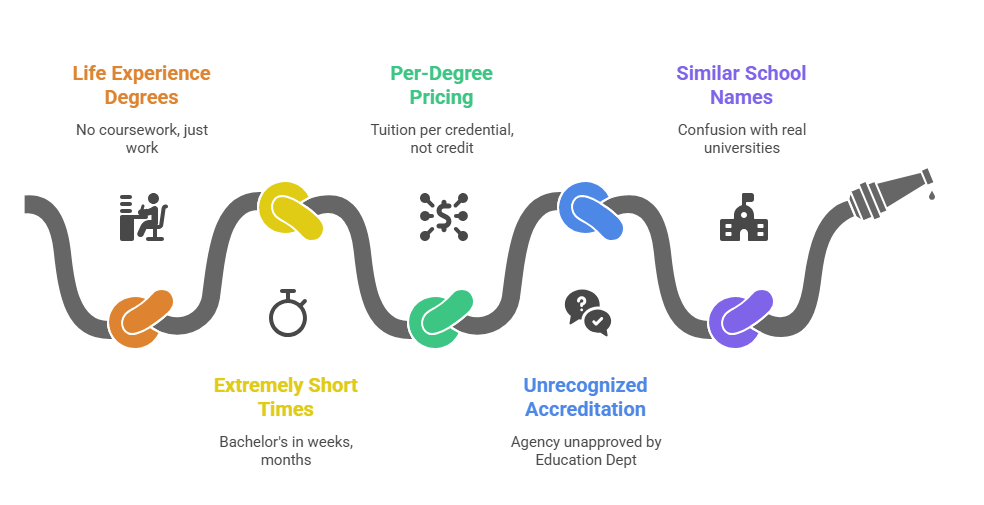
- Life experience degrees: Credentials awarded based solely on work experience without coursework
- Extremely short completion times: Bachelor's degrees completed in weeks or months
- Per-degree pricing: Tuition charged per credential rather than per credit hour
- Unrecognized accreditation: Claims of accreditation from agencies not approved by Department of Education
- Similar names to legitimate schools: Intentional confusion with established universities
Background screening specialists maintain updated diploma mill databases. These contain over 1,800 known fraudulent operations. This helps them flag suspicious credentials automatically. The Federal Trade Commission and FBI maintain lists of prosecuted diploma mill operations. Organizations like GetEducated.com publish annual diploma mill lists. These are based on accreditation verification research.
Common diploma mill names include "Barrington University," "Kennedy-Western University," and "Columbia State University." This last one is distinct from legitimate Columbia University. These operations have sold thousands of fraudulent degrees despite law enforcement actions. Employers must remain vigilant in identifying these fraudulent credentials.
International Accreditation Recognition
International online degree verification requires understanding diverse accreditation frameworks. These vary across different countries and educational systems. European institutions follow the Bologna Process standards. Australian universities operate under the Tertiary Education Quality and Standards Agency (TEQSA). Canadian programs receive provincial authorization and national accreditation. Credential evaluation services like World Education Services (WES) and Educational Credential Evaluators (ECE) specialize in assessing international credential equivalency to U.S. standards.
| Region | Accreditation Authority | Verification Timeline | Common Challenges |
| Europe | Bologna Process/National Agencies | 7-10 business days | GDPR privacy restrictions |
| Australia | TEQSA | 5-7 business days | Time zone coordination |
| Canada | Provincial + Federal Bodies | 5-7 business days | Provincial variations |
| Asia | Country-specific agencies | 10-14 business days | Language barriers |
| Latin America | National education ministries | 10-14 business days | Limited digital infrastructure |
Online programs offered by foreign universities to U.S. students present particular verification challenges. Some international schools hold legitimate accreditation in their home countries. However, they lack U.S. recognition. This creates ambiguity about credential legitimacy.
FCRA Compliance in Online Education Verification
Fair Credit Reporting Act regulations govern all employment background checks. This includes education verification for online degrees. FCRA compliance protects candidate rights. It also establishes legal frameworks for employers conducting pre-employment screening. Violations carry substantial penalties. FTC enforcement actions have resulted in settlements ranging from $500,000 to $13 million. These apply to companies failing to follow proper procedures.
Employers must provide clear disclosure that background checks will be conducted. They must obtain written authorization before initiating verification. They must also furnish candidates with adverse action notices if verification results influence hiring decisions. The disclosure must be standalone documents. They cannot be buried within employment applications or offer letters. Authorization forms should use plain language. They should explain what verification encompasses, how information will be used, and candidate rights under FCRA.
Consumer reporting agencies conducting verification must follow reasonable procedures. This ensures maximum possible accuracy of education records. This includes attempting multiple verification methods when initial attempts fail. It also means contacting institutions directly rather than relying solely on questionable third-party databases. Agencies must also provide dispute resolution mechanisms when candidates challenge findings.
Authorization and Disclosure Requirements
FCRA Section 604 requires employers to provide candidates with clear, conspicuous disclosure documents. These explain that consumer reports (background checks) will be obtained for employment purposes. These disclosures must appear on standalone documents. They cannot include extraneous information about company policies, liability waivers, or employment terms. Many FCRA lawsuits stem from disclosure documents that bundle background check authorization with other employment paperwork. This violates the standalone requirement.
Written authorization obtained from candidates must be explicit and informed. This means candidates understand what verification encompasses. They must voluntarily agree to the screening. Electronic authorizations through applicant tracking systems satisfy FCRA requirements. However, they must meet E-SIGN Act standards. This includes clear consent actions like clicking "I agree" buttons. It also means providing candidates with copies of signed authorizations.
Adverse Action Procedures for Verification Failures
When online degree verification background check results reveal problems, employers must follow FCRA's adverse action procedures. These problems include unverifiable credentials, fraudulent diplomas, or significant discrepancies. The process begins with pre-adverse action notices. These provide candidates with copies of consumer reports and summaries of rights under FCRA. They also include reasonable time periods (5-7 business days) to dispute or clarify findings.
The adverse action process includes these mandatory steps:
- Pre-adverse action notice: Provide background check copy and rights summary before final decision
- Waiting period: Allow 5-7 business days minimum for candidate response
- Final adverse action notice: Send after final rejection decision with specific reasons and CRA contact information
- Documentation retention: Maintain all notices, candidate responses, and decision rationale for 1-2 years minimum
Candidates who dispute verification findings have rights to request reinvestigations. During these reinvestigations, background screening companies must recontact educational institutions. They must review verification methodologies and correct any inaccuracies. Employers should maintain flexible policies. These should allow candidates reasonable opportunities to provide supporting documentation. This includes official transcripts, diploma copies, or registrar letters addressing discrepancies.
Record Retention and Privacy Considerations
FCRA requires employers to maintain background check records for specific retention periods. This depends on hiring outcomes and includes education verification documentation. Records for hired employees should be retained for at least one year post-termination. Rejected candidate records must be kept for one year from adverse action dates. Some state laws impose longer retention requirements. California requires two years. New York requires four years in certain circumstances.
Privacy considerations extend beyond FCRA. They include Family Educational Rights and Privacy Act (FERPA) regulations. These govern educational institution disclosure of student records. Universities can release directory information without student consent. This includes enrollment dates, degrees earned, and conferral dates. However, detailed academic records require authorization. Background screening companies navigate these privacy frameworks through established institutional agreements. They also use candidate authorization protocols.
Common Verification Challenges and Solutions

Verification challenges arise from closed institutions, international credentials, and varying privacy regulations. Approximately 8-12% of online degree verifications encounter complications due to institutional closures. This is particularly true among for-profit universities. They experienced high failure rates between 2015-2022. The Department of Education requires closing institutions to designate record custodians. These custodians are responsible for maintaining transcripts and responding to verification requests indefinitely.
State education departments typically assume custodianship when institutions close without designating successors. This creates centralized repositories for defunct school records. For example, the Illinois Board of Higher Education maintains records for dozens of closed Illinois institutions. California's Bureau for Private Postsecondary Education serves similar functions. Background screening specialists must research institutional closure circumstances. They must identify current record custodians and navigate varying verification procedures.
Verification for Closed or Merged Institutions
When online universities close operations, merge with other institutions, or rebrand under new names, education verification becomes significantly more complex. Record custodians maintain transcript databases and respond to verification requests. However, locating them requires specialized knowledge. Many state education departments maintain searchable databases. These identify record custodians for closed institutions, streamlining the verification process considerably.
Background screening companies typically maintain proprietary databases of closed institution record custodians. These include contact information, verification procedures, and processing times.
Notable closed institution cases that impact verification:
- Argosy University (2019): 13,000 students across 22 locations; records maintained by receiver and Department of Education
- ITT Technical Institute (2016): 35,000 students affected; state education departments assumed custodianship
- University of Phoenix restructuring: Multiple campus closures with records transferred to remaining locations
- Corinthian Colleges (2015): 72,000 students; records distributed across state agencies and successor institutions
This institutional knowledge allows verification specialists to authenticate credentials from defunct schools efficiently. It prevents delays that would otherwise occur.
International Verification Complications
International online degree verification introduces complexities. These include time zone coordination, language barriers, and varying educational system structures. European institutions following GDPR often require additional authorization documentation. They need this before releasing student records to third parties. This extends verification timelines by 5-10 business days compared to domestic verifications. Different countries maintain different privacy standards. These affect how quickly and completely institutions respond to verification requests.
Credential evaluation becomes essential when international online degrees don't translate directly to U.S. educational frameworks. A three-year bachelor's degree is common in many countries. It may require evaluation to determine U.S. equivalency. Professional qualifications like UK's HND (Higher National Diploma) occupy ambiguous positions. They fall between associate and bachelor's degrees. Organizations like NACES members provide standardized evaluation reports. These assess international credentials against U.S. standards.
Privacy Regulations and Consent Requirements
State privacy laws like California Consumer Privacy Act (CCPA) and Virginia Consumer Data Protection Act impose additional requirements. These go beyond FCRA for education verification processes. These regulations grant candidates rights to know what information is collected. They also need to know how it's used and with whom it's shared during background checks. Employers must update authorization forms to address state-specific privacy provisions. They must also maintain FCRA compliance standards simultaneously.
Some universities, particularly international institutions, require candidates to initiate verification requests directly. They don't allow authorizing third-party inquiries. This "candidate-initiated" verification model satisfies institutional privacy policies. However, it complicates employer verification workflows. Background screening companies navigate these requirements through candidate portals. Applicants use these to request official transcripts or verification letters. These are sent directly to employers or screening agencies.
Best Practices for Employers and HR Professionals
Implementing effective online degree verification background check protocols requires balancing thoroughness with efficiency. HR professionals should establish documented education verification policies. These should align with organizational hiring standards, position requirements, and legal compliance obligations. Written policies create consistency across hiring managers. They protect against discrimination claims and provide clear frameworks for handling verification discrepancies.
Education verification should be risk-based and position-appropriate. This focuses resources on roles where credentials directly impact job performance. Executive positions, licensed professional roles, academic positions, and healthcare jobs warrant comprehensive verification. This includes degree authentication, attendance dates, major confirmation, and sometimes GPA verification. Entry-level positions with minimal education requirements may need only basic degree confirmation. Extensive major or date verification isn't always necessary for these roles.
Developing Comprehensive Verification Policies
Effective education verification policies specify which positions require verification. They also define what credential elements need authentication. This includes degree type, major, dates, and sometimes GPA. Policies should distinguish between degree requirements and degree preferences. Degree requirements mean candidate must possess specific credentials. Degree preferences mean credentials are beneficial but not mandatory. This ensures consistent application across similar positions to avoid discrimination risks.
Documentation requirements should be clearly communicated to candidates during application processes. Request official transcripts for finalist candidates. Alternatively, explain that background checks will verify self-reported education.
Position-based verification requirements should include:
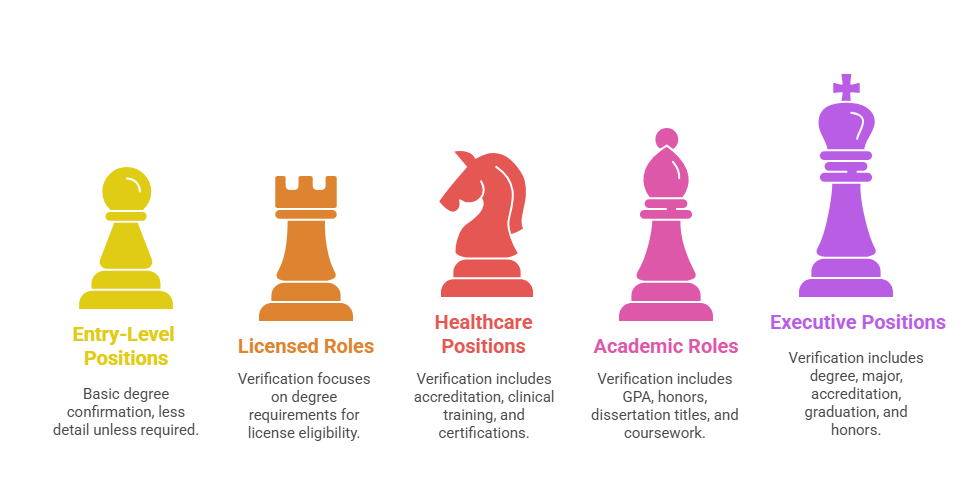
- Executive and Leadership Positions: Full verification including degree type, major, institution accreditation, graduation dates, and honors
- Licensed Professional Roles: Comprehensive verification with focus on specific degree requirements for licensure eligibility
- Healthcare and Medical Positions: Detailed verification including program accreditation, clinical training components, and specialized certifications
- Academic and Research Roles: Extensive verification including GPA, honors, dissertation titles, and sometimes coursework confirmation
- Entry-Level Positions: Basic degree confirmation without extensive detail verification unless specifically required
Some organizations conduct preliminary application screening using candidate-provided documents. They do this before investing in third-party verification for final candidates. This balances cost efficiency with comprehensive screening.
Cost-Benefit Analysis of Verification Investments
Education verification costs vary significantly based on methodology, turnaround time requirements, and vendor selection. Basic automated clearinghouse verifications cost $15-$25 per credential. Comprehensive verifications involving registrar contact, international authentication, or expedited processing range from $40-$75 per degree. Organizations conducting high-volume hiring should negotiate package pricing. This offers better per-verification costs for annual volume commitments.
The cost of inadequate verification far exceeds screening expenses. This happens when credential fraud enables unqualified hires. These hires can damage organizational reputation and create liability exposure. They may also perform poorly due to lacking required knowledge. Healthcare organizations face particular risks when fraudulent medical degrees lead to patient care by unqualified providers. Educational institutions hiring faculty with unverified credentials undermine academic integrity and accreditation standing. Investment in thorough verification protects organizations from these devastating consequences.
Conclusion
Online degree verification background check processes have evolved dramatically. This addresses the exponential growth in digital education following global pandemic disruptions. Modern verification combines traditional registrar contact with sophisticated technologies. These include National Student Clearinghouse databases, blockchain credentials, and AI-powered fraud detection systems. These authenticate credentials faster and more accurately than historical methods. Employers navigate verification challenges including diploma mills, international credentials, and closed institutions. Understanding accreditation standards and implementing comprehensive verification policies becomes essential. This maintains hiring integrity while respecting candidate rights under FCRA regulations. The future of education verification will be shaped by continued technology innovation and regulatory evolution. The ongoing shift toward instantly verifiable digital credentials will eliminate verification delays. It will provide cryptographically secured authenticity confirmation.
Frequently Asked Questions
Here are some common concerns for both job seekers and companies with regards to online verification of degrees. These answers provide information on timelines, costs, process, and what to expect in modern recruitment scenarios concerning online verification of credentials.
How long does online degree verification take during background checks?
Most online degree verifications through the National Student Clearinghouse complete within 24-48 hours. This covers participating institutions representing 98% of U.S. students. Verifications requiring direct registrar contact typically take 5-7 business days. International online degree authentication may require 7-14 days. Blockchain-based digital credentials from participating universities enable instant verification. This uses cryptographic validation without contacting institutions.
Can employers verify online degrees from closed universities?
Yes, employers can verify degrees from closed universities. They use designated record custodians, state education departments, or successor institutions. These entities acquired educational records. The Department of Education requires closing institutions to establish permanent record maintenance arrangements. Background screening companies maintain databases of closed institution record custodians. This facilitates these verifications.
Are online degrees verified differently than traditional campus degrees?
No, accredited online degrees undergo identical verification processes as traditional campus-based credentials. They use the same databases, registrar contacts, and authentication protocols. Regionally accredited universities issuing both online and campus degrees maintain unified records systems. They don't distinguish verification procedures by program delivery method. The key distinction involves verifying institutional accreditation status. This is more important than focusing on whether education was delivered online or in-person.
How much does online degree verification cost employers?
Education verification costs range from $15-$25 per credential for automated clearinghouse searches. Comprehensive verifications cost $40-$75. These involve direct registrar contact, international authentication, or expedited processing. Most background screening packages include education verification within comprehensive screening fees of $30-$150. This depends on package components. High-volume employers often negotiate discounted rates through annual screening contracts.
What happens if an online degree cannot be verified?
When degrees cannot be verified, employers must follow FCRA adverse action procedures. This includes pre-adverse action notices giving candidates 5-7 business days. They can provide clarifying documentation or dispute findings during this time. Candidates may submit official transcripts, registrar letters, or diploma copies to resolve verification issues. Approximately 15-20% of verifications encounter initial difficulties. Most resolve through candidate cooperation and additional verification attempts.
How do background checks detect fake online degrees?
Background screening companies detect fraudulent credentials through several methods. National Student Clearinghouse database searches reveal non-enrollment. Diploma mill databases contain known fraudulent operations. Accreditation verification confirms institutional legitimacy. AI-powered document analysis also detects forged transcripts or diplomas. Verification specialists identify suspicious patterns. These include unusually short degree completion times and unrecognized accreditation claims.
Do I need candidate permission to verify their online degree?
Yes, FCRA requires employers to obtain written authorization before conducting any background check. This includes education verification. Candidates must receive standalone disclosure documents. These explain that consumer reports will be obtained. They must provide explicit written consent before verification begins. Electronic authorizations through applicant tracking systems satisfy FCRA requirements. However, they must meet clear consent standards.
Can blockchain credentials replace traditional degree verification?
Blockchain credentials enable instant verification without contacting institutions. This uses cryptographic validation of digital diplomas issued by participating universities. However, as of 2025, fewer than 5% of institutions issue blockchain credentials. Traditional verification methods remain necessary for the vast majority of online degrees. Blockchain adoption rates are increasing 25-30% annually though.
How are international online degrees verified?
International online degree verification requires contacting foreign university registrars directly. It also uses international verification services like those provided by NACES member organizations. Some cases require obtaining credential evaluation reports. These assess foreign degree equivalency to U.S. standards. Verification timelines extend 7-14 business days beyond domestic verifications. This is due to time zone coordination, language translation requirements, and varying privacy regulations.
What should I do if my online degree verification shows discrepancies?
Candidates discovering discrepancies should immediately contact the background screening company. They should provide clarifying documentation like official transcripts, registrar letters, or diploma copies. Common discrepancies stem from incorrect dates or name changes not updated in institutional records. Confusion between program completion and official degree conferral dates also causes issues. FCRA guarantees candidates' rights to dispute findings and request reinvestigation.
Additional Resources
- National Student Clearinghouse - DegreeVerify Education Verification Services
https://www.studentclearinghouse.org/colleges/degreeverify/ - U.S. Department of Education - Database of Accredited Postsecondary Institutions and Programs
https://ope.ed.gov/dapip/ - Federal Trade Commission - Fair Credit Reporting Act Guidance for Employers
https://www.ftc.gov/business-guidance/resources/using-consumer-reports-what-employers-need-know - Professional Background Screening Association - Accreditation Standards
https://www.pbsa.org/accreditation/ - National Association of Credential Evaluation Services - International Degree Verification
https://www.naces.org/ - Council for Higher Education Accreditation - Recognized Accrediting Organizations
https://www.chea.org/chea-recognized-organizations - MIT Digital Credentials Consortium - Blockchain Credential Verification
https://digitalcredentials.mit.edu/
Still have questions?
Get in touch with our team today for a personalized demo and discover how our tailored volume pricing and packages can drive results for your business!
How useful was this page?*
Note: your comments are anonymous. We use them to improve the website. Do not include any personal details.
Visit our FCRA Compliance Tool or leave a message here if you need a response.
From the blog Explore the GCheck Content Hub

How Long Does a Background Check Take? A Complete 2025 Guide
13 Dec, 2023 • 14 min read
The Ultimate Background Check Guide
13 Dec, 2023 • 4 min read
The Ultimate Guide to Employment Background Checks
13 Dec, 2023 • 10 min readThe information provided in this article is for general informational and educational purposes only and should not be construed as legal advice or a substitute for consultation with qualified legal counsel. While we strive to ensure accuracy, employment screening laws and regulations—including but not limited to the Fair Credit Reporting Act (FCRA), Equal Employment Opportunity Commission (EEOC) guidelines, state and local ban-the-box laws, industry-specific requirements, and other applicable federal, state, and local statutes—are subject to frequent changes, varying interpretations, and jurisdiction-specific applications that may affect their implementation in your organization. Employers and screening decision-makers are solely responsible for ensuring their background check policies, procedures, and practices comply with all applicable laws and regulations relevant to their specific industry, location, and circumstances. We strongly recommend consulting with qualified employment law attorneys and compliance professionals before making hiring, tenant screening, or other decisions based on background check information.


